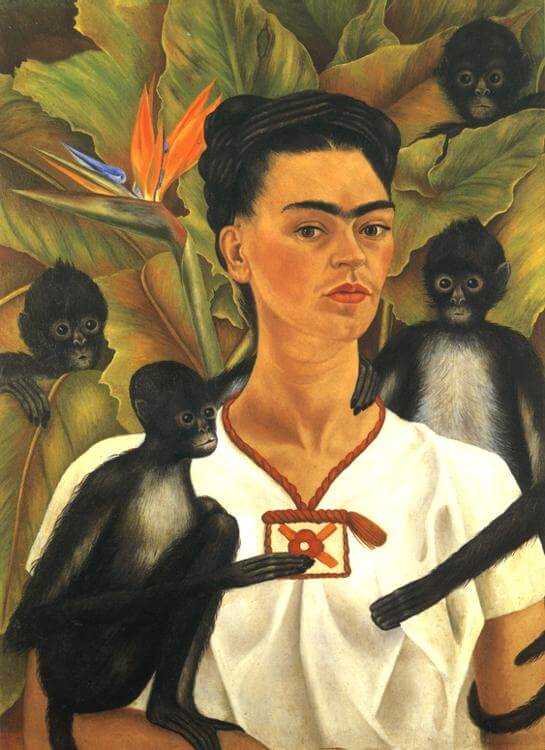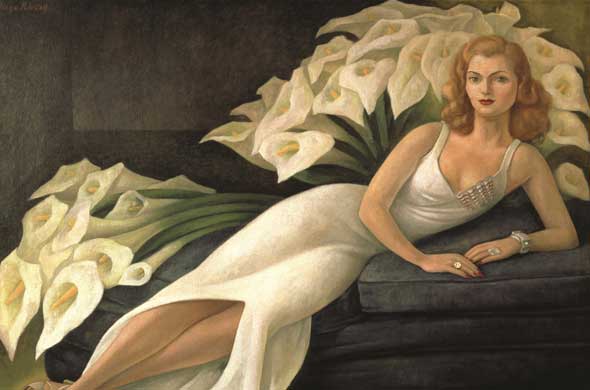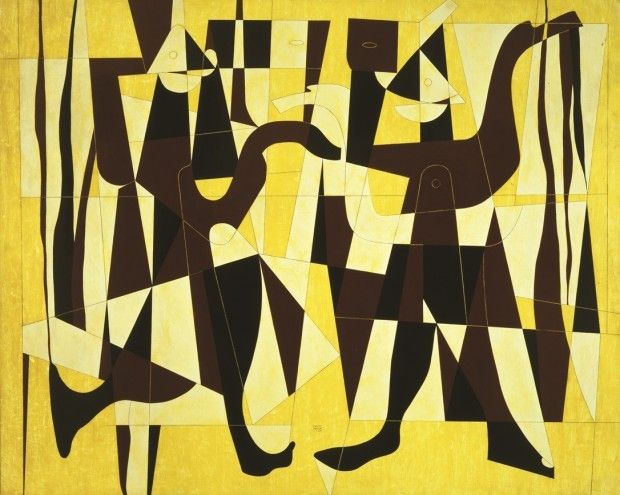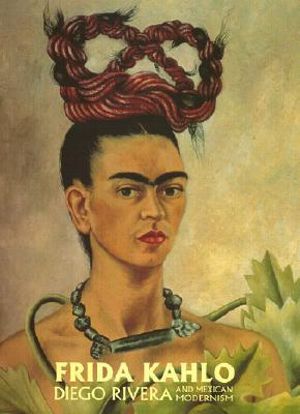Fiery passion and the warm, festive atmosphere of Mexico define an exhibition opening on June 1 at The Nelson-Atkins Museum of Art in Kansas City. Frida Kahlo, Diego Rivera and Masterpieces of Modern Mexico from the Jacques and Natasha Gelman Collection showcases more than 100 paintings, sculptures, photographs and drawings collected by the Gelmans in their adopted homeland of Mexico.
“When the Don Hall Initiative was created at the beginning of my tenure with the Nelson-Atkins, we hoped to bring exhibitions here that would reverberate in the community,” said the Mexico City-born Julián Zugazagoitia, CEO and Director. “The Gelman Collection has universal appeal but is so close to my personal history that we are thrilled to present these masterpieces to Kansas City.”
Jacques Gelman, a Russian-born film production mogul, and Natasha, his Czechoslovakian-born wife, became Mexican citizens in 1942 following the couple’s marriage in 1941. Over the next five decades, the Gelmans supported generations of internationally renowned Mexican artists. They established friendships with and collected art by such icons of Mexican modernism as Frida Kahlo, Diego Rivera, David Alfaro Siqueiros, Rufino Tamayo, and Gunther Gerzso, among others.
The Gelman Collection is the realization of an intimate collaboration spanning more than 40 years; it was the predominant passion of Jacques and Natasha. The collection began in 1943 with Rivera’s portrait of Natasha Gelman and continued to grow even after Jacques’ death in 1986. The couple collected art without hesitation. They acquired the canvases of Kahlo and Rivera when there were only a handful of collectors in Mexico.
Although their styles were radically different, Kahlo and Rivera were similarly captivated by painting’s potential to explore the human condition. Rivera painted massive murals depicting the heroic struggle of Mexican society forging its future; Kahlo explored the inner workings of her soul, which reflect the female condition today, in a series of self-portraits that revealed her tragic medical history and affirmed her Mexican identity.
The Gelman collection is, in and of itself, a work of art. It is also a work in progress. Owing to the enthusiasm they felt for Mexican art, the Gelmans desired that their collection be kept up to date. Works by significant contemporary artists such as Paula Santiago, Betsabeé Romero, Francis Alÿs and Gabriel Orozco have recently entered the Gelman collection. Thanks to the discerning eye of its president, Robert Littman, the collection continues to grow and evolve according to the forward-thinking couple’s wishes.
The exhibition includes key images by Kahlo such as

Self Portrait with Monkeys,(1943)
and Self Portrait as a Tehuana or Diego in My Thoughts, (below)

and the major work by Rivera, Calla Lily Vendors1943).
Reflecting the Gelmans' personal tastes, their collection of Mexican art includes many portraits of themselves, such as
Rufino Tamayo's Portrait of Mrs. Natasha Gelman (1948)

and Ángel Zárraga's Portrait of Mr. Jacques Gelman (1945).
Throughout the post-World War II artistic boom in Mexico, the Gelmans befriended a long list of renowned artists, including Kahlo, Diego Rivera and David Alfaro Siqueiros. Consequently, their collection of Mexican works reveals not only their passion for art, but also their blossoming relationships with such artists.
The paintings are supplemented by a display of the rarely-seen photographs by Frida Kahlo' s father Guillermo Kahlo (1872-1941) depicting churches and cloisters around Mexico City and Tepotzlan, alongside views from the Palace in Chapultepec Park. Their inclusion allows, for the first time in this country, the work of Frida Kahlo to be placed alongside and put into context with the two most important men in her life.
The exhibition is further extended with a selection of photographs by another key artistic couple who offer a significant glimpse of Mexico's cultural history, the photographers Manuel Álvarez Bravo (1902-2002) and Lola Álvarez Bravo (1905-1993). Manuel famously photographed the Mexican Muralists, and his cinematic images of Mexico speak of the mystery of everyday life and contemporary political and social problems. Lola began taking photographs under the influence of her husband in the 1920s and worked in a number of photographic genres such as nudes, still life, landscape, photomontage and portraits. She was a close friend of Frida Kahlo, and hosted Frida's first solo exhibition in Mexico in her gallery (Galería de Arte Mexicano) in 1953.
Frida Kahlo, Diego Rivera and Masterpieces of Modern Mexico from the Jacques and Natasha Gelman Collection runs through Aug. 18 at the Nelson-Atkins and showcases an exceptional private collection that not only highlights the rich and vibrant artistic traditions of the Mexico of yesterday, but underscores the inventiveness and vitality of Mexican art today.

Frida Kahlo (Mexican, 1907–1954). Diego en mi pensamiento (Diego on My Mind), 1943. Oil on Masonite, 29 7/8 x 24 inches. The Jacques and Natasha Gelman Collection of 20th Century Mexican Art. The Vergel Foundation. Conaculta/INBA. © 2013 Banco de México Diego Rivera Frida Kahlo Museums Trust, Mexico, D.F. / Artists Rights Society (ARS), New York.

Diego Rivera (Mexican, 1886–1957). Retrato de la Señora Natasha Gelman (Portrait of Mrs. Natasha Gelman), 1943. Oil on canvas, 45 1/4 x 60 1/4 inches. The Jacques and Natasha Gelman Collection of 20th Century Mexican Art. The Vergel Foundation. Conaculta/INBA. © 2013 Banco de México Diego Rivera Frida Kahlo Museums Trust, Mexico, D.F. / Artists Rights Society (ARS), New York.

Carlos Mérida (Guatemalan, 1891–1984). El mensaje (The Message), 1960. Painted board, 28 x 34 5/8 inches. The Jacques and Natasha Gelman Collection of 20th Century Mexican Art. The Vergel Foundation. © 2013 Artists Rights Society (ARS), New York / SOMAAP, Mexico City.
Interesting article
This exhibition has been organized by The Nelson-Atkins Museum of Art with the Vergel Foundation. Support has been received from The Keith and Margie Weber Foundation, Belger Cartage Service, Inc., the Campbell-Calvin Fund and Elizabeth C. Bonner Charitable Trust for exhibitions and our generous donors to the Annual Fund.
The Nelson-Atkins Museum of Art
The Nelson-Atkins in Kansas City is recognized nationally and internationally as one of America’s finest art museums. The Nelson-Atkins serves the community by providing access and insight into its renowned collection of more than 33,500 art objects and is best known for its Asian art, European and American paintings, photography, modern sculpture, and new American Indian and Egyptian galleries. Housing a major art research library and the Ford Learning Center, the Museum is a key educational resource for the region. The institution-wide transformation of the Nelson-Atkins has included the 165,000-square-foot Bloch Building expansion and renovation of the original 1933 Nelson-Atkins Building.
The Nelson-Atkins is located at 45th and Oak Streets, Kansas City, MO. Hours are Wednesday, 10 a.m.–4 p.m.; Thursday/Friday, 10 a.m.–9 p.m.; Saturday, 10 a.m.–5 p.m.; Sunday, Noon–5 p.m. Admission to the museum is free to everyone. For museum information, phone 816.751.1ART (1278) or visit nelson-atkins.org.

Catalogue
